Symptoms
Bacterial wilt is a newly discovered disease of blueberry in Florida. Symptoms of the disease are similar to those caused by Xylella and bacterial scorch. Plants with bacterial wilt will show signs of water stress such as wilting and marginal leaf burn (Figures 1 and 2). Plants with bacterial wilt may also be prone to developing severe symptoms of other stress diseases, such as stem blight, in the affected patches and thus may show symptoms of both diseases. The crowns of blueberry plants with bacterial wilt have a mottled discoloration or light brown to silvery purple blotches with ill-defined borders (Figure 3). This discoloration is distinct from that which occurs with stem blight disease; stem blight discoloration is typically pie piece-shaped and pecan brown in color. Additionally, wood chips floated in water from the crowns of plants with bacterial wilt will stream bacterial ooze (Figure 4). Stem blight-infected wood chips do not.
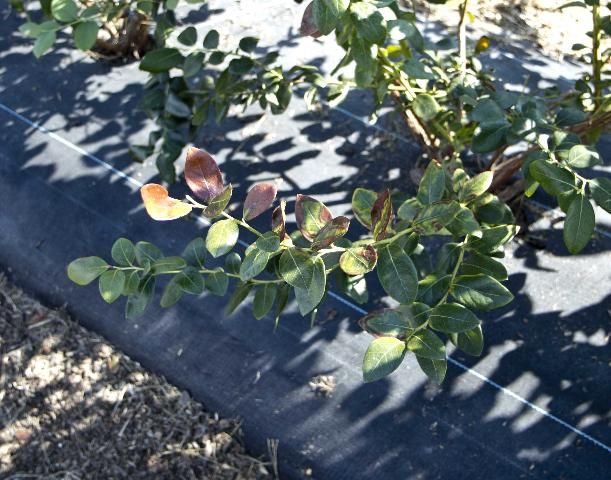
Credit: Philip Harmon, UF/IFAS
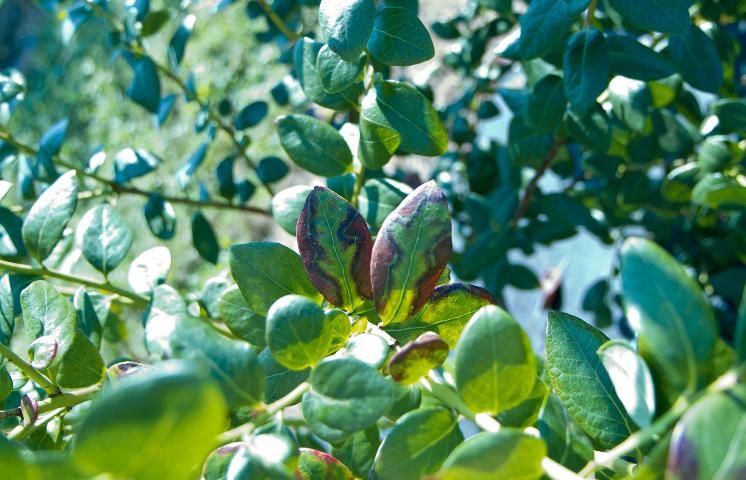
Credit: Philip Harmon, UF/IFAS
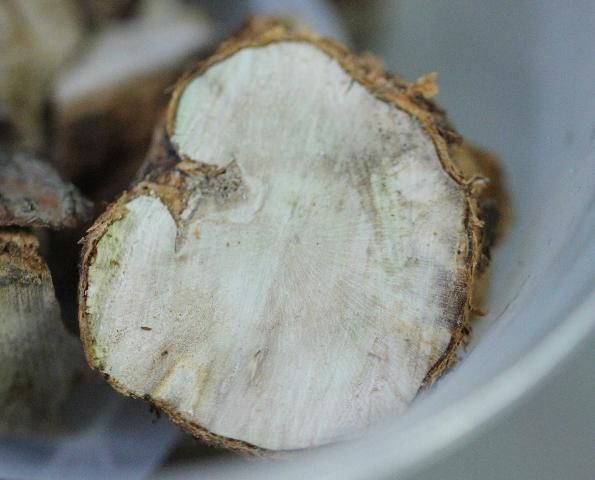
Credit: Philip Harmon, UF/IFAS

Credit: Philip Harmon, UF/IFAS
Unlike Xylella, which causes bacterial leaf scorch, this Ralstonia can be spread easily in water, soil, or through infected plant material. Plants can be infected without showing symptoms. Ralstonia can survive for years in soil, slowly spreading down and across rows of blueberry, leaving large circular patches of dead and dying plants (Figures 5 and 6). These symptoms are similar in appearance to Phytophthora root rot-affected areas, but do not necessarily occur only in low-lying and poorly drained soils. Once introduced to a farm or nursery facility, the pathogen is spread most efficiently in recycled irrigation water and ponds used for irrigation. Ralstonia can also be moved from plant to plant on pruning and other equipment.
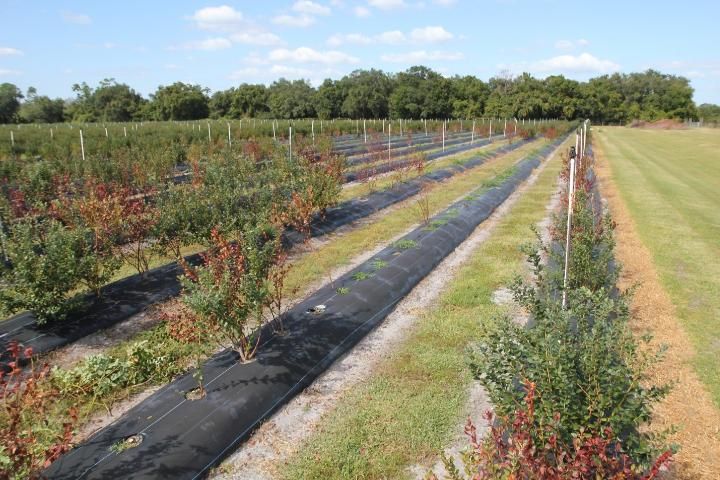
Credit: Philip Harmon, UF/IFAS
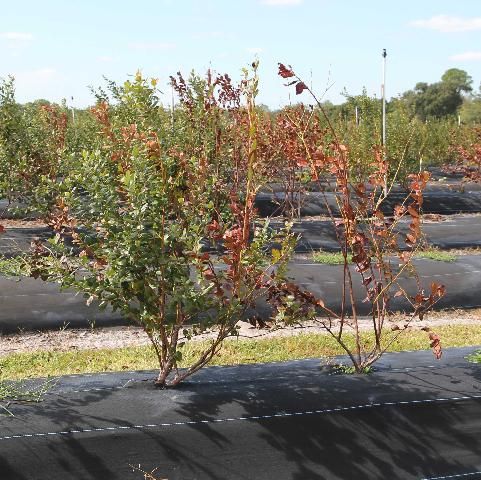
Credit: Philip Harmon, UF/IFAS
Occurrence in Florida
The disease was initially confirmed on three farms in Florida, two in DeSoto County and one in Orange County. On all three farms, the blueberry variety 'Arcadia' was the most severely affected. Other varieties may also be susceptible, but additional research is needed before we will know for sure. Although this is the first time the disease has been confirmed on blueberry in Florida, populations of the pathogen are common in Florida on other hosts. Ralstonia solanacearum causes diseases on a wide range of other plants including geranium, tomato, potato, peppers, and several other weedy, ornamental, and crop plants. We do not know why it has only now been found causing disease on blueberry. There has only been one other case of bacterial wilt on highbush blueberry known, and that was confirmed on a single farm in New Jersey in 2012 by scientists at Rutgers.
Management
To manage the disease, make every effort to keep from introducing the bacterium onto your farm. The risk of introduction can be reduced by limiting the movement of soil or infected plant materials between farms on equipment and workers' tools, such as tractors, pickups, pruning shears, etc. Mud transferred from farm to farm on vehicles during freeze protection is another possible mechanism. Purchase and use only healthy plants that are free of disease.
Where the bacterium is detected, remove and burn or deep-bury infected plants. Then, use soil drenches of products with phosphorous acids or salts to help protect surrounding plants from infection. Do this prior to replanting. K-Phite is an example product that is labeled for blueberry and for soil drench or chemigation application for Ralstonia control. For chemigation application through drip, use 2 to 4 quarts in at least 200 gallons of water per acre. For an application to soil, use 2 to 4 quarts in a minimum of 20 gallons per acre then lightly apply overhead irrigation after application. Potted plants can be drenched with a solution of 2 to 4 quarts of K-Phite in 100 gallons of water prior to planting in fields where the disease has occurred. On other crops, this method has successfully protected plants from infection. Follow-up applications made according to the label are also recommended and can be made on a 7- to 28-day interval. Similar alternative products are available from other manufacturers.
Injection or soil applications are currently recommended for the variety 'Arcadia' wherever planted and for all varieties on farms where the disease has been confirmed.
Testing for Bacterial Wilt
Send samples of 'Arcadia' showing wilt, scorch, or plant death that moves down rows to your local UF/IFAS Extension agent or directly to the UF/IFAS Plant Diagnostic Center in Gainesville, Florida for a diagnosis. Plants that are sampled from the affected areas should be sick but not dead. We need a fresh crown to test, so use an overnight or two-day shipping option. The lab is covering the diagnostic fees for culturing and PCR to support the delimitation and management strategy. The address is below. Include a sample submission form that indicates the plant location, variety, and the need for bacterial wilt testing. Call the lab with any sample or shipping questions; test results will be emailed to the sample submitter and the blueberry pathology Extension specialist.
Direct questions concerning bacterial wilt to the state blueberry pathology Extension specialist Dr. Phil Harmon. Office phone: 352-273-4622, and email: pfharmon@ufl.edu.
Diagnostic Center website: https://plantpath.ifas.ufl.edu/extension/plant-diagnostic-center/
The form: https://plantpath.ifas.ufl.edu/extension/plant-diagnostic-center/
Dr. Carrie Lapaire Harmon, director, Plant Diagnostic Center
UF/IFAS Plant Diagnostic Center
Bldg. 1291, 2570 Hull Road
Gainesville, FL 32611
352-392-1795
pdc@ifas.ufl.edu